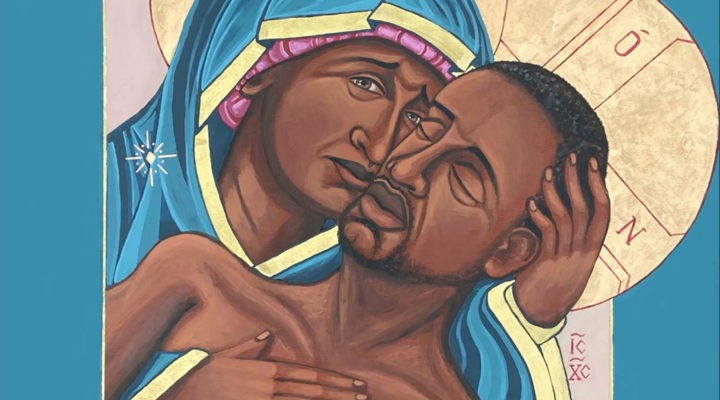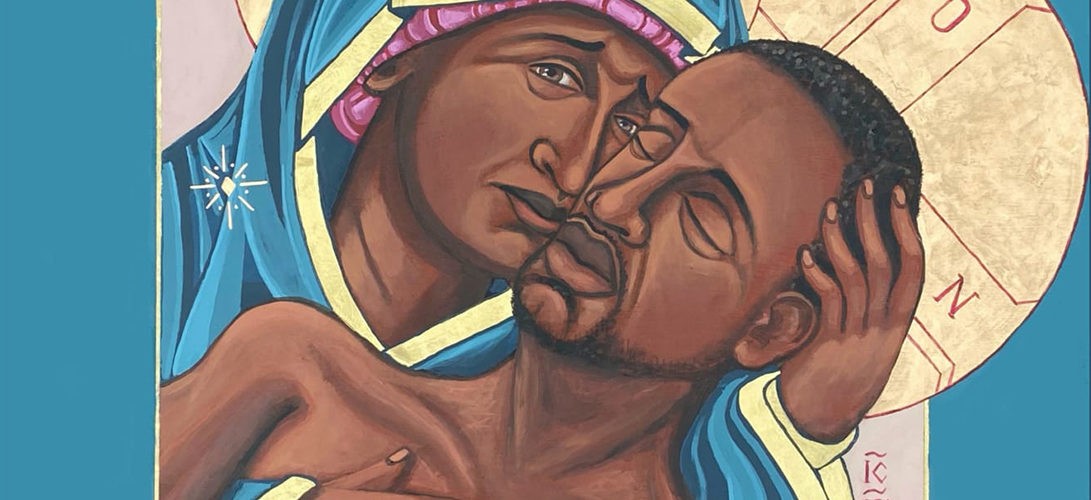Just ahead of the first Sunday of Advent this year, a painting depicting Mary cradling the body of the crucified Jesus was stolen from the wall outside the Mary Mirror of Justice Chapel at Catholic University of America law school, just down the street from my neighborhood.
The contemporary painting, titled “Mama,” was created in a well-known style referred to as a Pietà, meaning pity or compassion, most famously represented by Michelangelo’s white marble “Pietà” (1498-99) in St. Peter’s Basilica in Vatican City.
As Jack Jenkins at Religion News Service reported, the painting — and Kelly Latimore, the St. Louis-based artist who created it — were targeted after the Daily Signal, a website owned by the conservative Heritage Foundation think tank, posted a critical story about it on Nov. 22. An online petition claiming to be from Catholic University of America students quickly gathered more than 4,500 signatures.
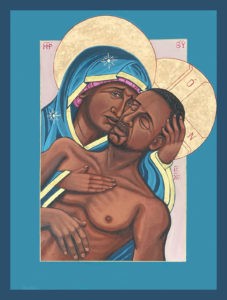 The objections? Both Mary and Jesus are depicted with brown skin. And the figure of Jesus in the 2020 painting bears a likeness to George Floyd, whose dying words included the heart-wrenching cries, “Mama … Mama!”
The objections? Both Mary and Jesus are depicted with brown skin. And the figure of Jesus in the 2020 painting bears a likeness to George Floyd, whose dying words included the heart-wrenching cries, “Mama … Mama!”
CUA officials received numerous comments that they characterized as “racist and offensive.” Latimore received death threats. And then the painting disappeared.
In an interview with RNS, Latimore — who is white and grew up in a white evangelical church — characterized the threats he received as “white supremacist, racist stuff,” including derogatory remarks about George Floyd, and objections to any depiction of Jesus as Black. But he understood the painting, commissioned to mourn the death of George Floyd, as consistent with the “nature of the personhood of Christ:”
Pietà
I believe Christ is in that image, just as much as it would be in a “normal” Pietà — the European version of Christ. In Matthew’s Gospel, Jesus asks us to find him in all people, especially those who suffer as George Floyd did.
For its part, CUA is to be commended for having the courage to display the painting, for refusing to bow to pressure to remove it, and for quickly replacing it with a smaller copy after the theft. In an open letter to the CUA community, CUA President John Garvey affirmed his goal to “build on campus a culture that engages in thoughtful dialogue and debate, not the sort of bully tactics epitomized by this theft.”
Such a response is admirable and fitting for CUA, given its unique status as a pontifical university of the Catholic Church and the only institution of higher education founded by the U.S. Catholic bishops.
But in the same document, Garvey also shared CUA’s official statement to the media, which falls far short of that worthy goal. It disappointingly embodies a lack of forthrightness and resolve, and it has squandered an important teaching opportunity for the academic institution.
CUA could have realized Garvey’s goal of engaging in thoughtful dialogue and debate — for example, by holding a forum with Catholic theologians, by inviting Latimore to campus to discuss the work, or by hosting a viewing and discussion of the service of blessing for the original icon “Mama” at Holy Communion Episcopal Church in Latimore’s hometown of St. Louis.
An example from the Vatican
As RNS reported, CUA could have followed precedents, some undertaken by the Vatican itself, for seeing such artistic license as theologically instructive and appropriate.
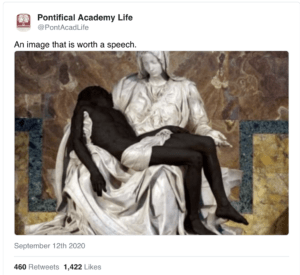 During 2020 — the same year Latimore’s “Mama” was created — the Pontifical Academy of Life, an official Vatican think tank founded by Pope John Paul II, tweeted a photo of Michelangelo’s Pietà featuring a Black Jesus and the caption, “An image that is worth a speech.” The head of the academy, Archbishop Vincenzo Paglia, explained that the photo was inspired by a 2015 statue by Italian sculptor Fabio Viale, created at the height of a European immigration crisis, which “portrayed a 22-year-old Nigerian who fled his country to avoid persecution due to his Christian faith.”
During 2020 — the same year Latimore’s “Mama” was created — the Pontifical Academy of Life, an official Vatican think tank founded by Pope John Paul II, tweeted a photo of Michelangelo’s Pietà featuring a Black Jesus and the caption, “An image that is worth a speech.” The head of the academy, Archbishop Vincenzo Paglia, explained that the photo was inspired by a 2015 statue by Italian sculptor Fabio Viale, created at the height of a European immigration crisis, which “portrayed a 22-year-old Nigerian who fled his country to avoid persecution due to his Christian faith.”
That image sparked a heated debate. But Archbishop Paglia believed that inviting Catholics of European descent to re-envision the body of Jesus in the context of a contemporary crisis was a creative way to advance the theological mission of the academy.
Instead, the CUA administration attempted to sidestep the fundamental issue. Incredibly, even though the catalyst for the painting — to mourn George Floyd’s death — is public knowledge, Garvey and CUA officials claimed not to see the connection to George Floyd: “There are those who would like to see George Floyd as the male figure in the icon. That is not how we read it,” they said in a media statement. “The image represents to our community a good-faith attempt to include religious imagery on campus that reflects the universality of the Catholic Church.”
The embodied Jesus
What does all this have to do with Advent, the season leading up to the celebration of the birth of Jesus at Christmas? The Pietà images are most closely related to a different part of the Christian liturgical calendar, Lent and Easter, which commemorate the death and resurrection of Jesus. But these two seasons, the contemplation of death and birth, both focus Christians on the body of Jesus. And in the evangelical Protestant world of my upbringing, where Easter was focused on a bare cross rather than a crucifix, it was Christmas that imaginatively evoked the most detailed images of an embodied Jesus.
“It was Christmas that imaginatively evoked the most detailed images of an embodied Jesus.”
In Christian theology, the Incarnation is inescapably tangible. The Gospel of John tells us that the Logos, or the Word — the unifying creative force in the universe — became flesh and dwelt among us. God took specific human form.
On white Christian mantels and white Christian church lawns across the country, Nativity scenes continue to depict, in illuminated plastic and with robed volunteers, a white holy family surrounded by a throng of other white folks. If there is anyone in the scene with brown skin — and there wasn’t until the 15th century — it is one of the three “wise men” or kings (specifically Balthasar, the one bringing the gift of myrrh).
 A quick online search shows the continued ubiquity of this representation. Retailer Montgomery Ward, for example, has the Nativity scene shown here available for purchase this year. The only brown-skinned figure is Balthasar. But everyone else — notably the angel and the baby Jesus, the two images connected with the divine — is white.
A quick online search shows the continued ubiquity of this representation. Retailer Montgomery Ward, for example, has the Nativity scene shown here available for purchase this year. The only brown-skinned figure is Balthasar. But everyone else — notably the angel and the baby Jesus, the two images connected with the divine — is white.
Intimate Incarnation
The Incarnation is also inescapably intimate. God comes near by becoming one of us. And we can identify with God by identifying with that human form. It’s natural, of course, for racial and ethnic groups to bridge that enormous gulf by imagining Jesus looked like them. The Washington National Cathedral, for example, has in past years hosted displays of Nativity scenes from all over the world that bear witness to this practice.
So why not a white baby Jesus for Americans of European descent? Given the history of white supremacy among us, there’s a particular danger in perceiving Jesus — the God-man born to save the world — as white. Setting aside the wild inaccuracy of such a conception (the biblical texts clearly tell us Jesus was a Jew of Middle Eastern descent), our contingent history creates theological peril.
If what’s past is prologue, we white Christians face a nearly irresistible temptation to turn a counterfactual imaginative act into a weapon of exclusion and domination.
Try this at home
If you are white and that sounds like a far-fetched claim, try this experiment. Suggest that your church modify its Nativity display to a scene that looks more like one of the images below, also by Kelly Latimore (Christ Church Cathedral in downtown Indianapolis, for example, has done just that this year). Or change the imagery that is part of your home celebration, especially if it’s publicly visible. How would your fellow congregation members, neighbors and extended family react?

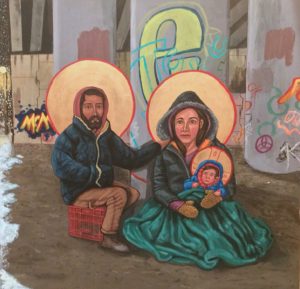 I confess that, growing up, I would have had a difficult time thinking about Jesus, the light coming into the world, as a baby with Black or brown skin. For most of us who were raised with a vision of “the little Lord Jesus asleep on the hay” as a chubby baby with smooth white skin, if we’re honest, Latimore’s images remain jarring — even if we intellectually know they shouldn’t be. And we also know that many of our neighbors, friends and extended family members would have visceral negative reactions to these images.
I confess that, growing up, I would have had a difficult time thinking about Jesus, the light coming into the world, as a baby with Black or brown skin. For most of us who were raised with a vision of “the little Lord Jesus asleep on the hay” as a chubby baby with smooth white skin, if we’re honest, Latimore’s images remain jarring — even if we intellectually know they shouldn’t be. And we also know that many of our neighbors, friends and extended family members would have visceral negative reactions to these images.
It’s these pre-verbal, pre-rational reactions, the unexpected dissonances, that help cast light on those dim corners where white supremacy still lurks in our theology. That uncomfortable realization creates the space for theological healing and growth.
A word from the artist
Because this work is not merely intellectual, artists can help us. In an interview featured on Latimore’s website, he expounded on his understanding of the theological work religious icons do:
An icon tries to take both symbol and meaning … and put it together in a proper way … . A community of faith can see that image of a person or a scene, and in an artful way, in a beautiful way, the community … can use it for a guide for its thought and its prayer, and therefore its action … . The icon gives the community … a vessel to see Christ not only in the community and the symbols it already has but in the world at large.
As the days continue to grow shorter, one way to use those extra evening hours in the glow of Advent candles is to sit with the dissonance. We can hold these alternative images before us as we read the familiar texts and sing the familiar carols, allowing this light, reflected on new surfaces, to enliven our moral and theological imaginations. In my experience, sometimes the resulting insights open new theological doors. And sometimes, painfully, but ultimately gratefully, they close others.
“This year at Advent, I’m reflecting on the theological importance of an expansive and inclusive understanding of the Incarnation.”
Human yet divine
This year at Advent, I’m reflecting on the theological importance of an expansive and inclusive understanding of the Incarnation. One of the central, enduring debates in early Christianity was about the proper understanding of this doctrine. How do we simultaneously affirm the divinity and the humanity of Jesus?
In these debates, the perpetual temptation was to sacrifice some part of Jesus’ humanity to resolve the inherent tension. But in a dictum that came to represent the orthodox Christological position, Gregory of Nazianzus asserted the necessity of affirming the full humanity of Jesus, “For that which He has not assumed He has not healed.”
If we take this ancient insight seriously, we have a responsibility to build a theology where all of humanity is assumed in the body of Jesus. We should be able to see it in a crucified body held in a mother’s arms. And, in this season of Advent, we should be able to see it in the images of a tender body lying in a manger.
As Latimore insightfully noted, this, “theologically, is what racism is: a complete denial of the Incarnation of Christ.”

Robert P. Jones (Photo by Noah Willman)
Robert P. Jones is CEO and founder of PRRI and the author of White Too Long: The Legacy of White Supremacy in American Christianity, which won a 2021 American Book Award.
This column originally appeared on Robert P. Jones’s substack #WhiteTooLong. In partnership with the author and PRRI, each Monday BNG will feature a new column from Jones.
Related articles:
A white Jesus can’t save a brown child | Opinion by Alecia Reyes-Barrientez
A white Jesus, the American Creed, and a nation badly divided | Opinion by Richard T. Hughes
Saving our churches from Dylann Roof’s white Jesus | Opinion by Robert P. Jones

